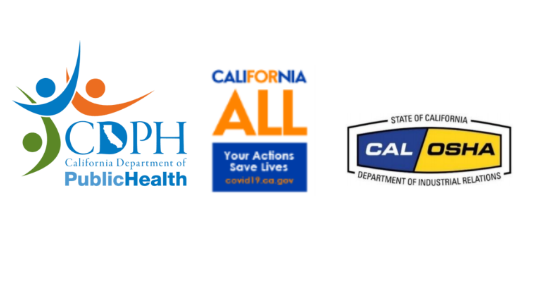Title Page
-
Conducted on
-
Prepared by
-
Location
Contents of Written Worksite Specific Plan
-
The person(s) responsible for implementing the plan.
-
A risk assessment and the measures that will be taken to prevent spread of the virus.
-
Training and communication with employees and employee representatives on the plan.
-
A process to check for compliance and to document and correct deficiencies.
-
A process to investigate COVID-cases, alert the local health department, and identify and isolate close workplace contacts of infected employees until they are tested.
Topics for Employee and Volunteer Training
-
Information on COVID-19, preventing spread, and who is especially vulnerable. <br>https://www.cdc.gov/coronavirus/2019-ncov/index.html
-
Self-screening at home, including temperature and/or symptom checks using CDC guidelines.<br>https://www.cdc.gov/coronavirus/2019-ncov/symptoms-testing/symptoms.html
-
The importance of not coming to work if employees have a frequent cough, fever, difficulty breathing, chills, muscle pain, headache, sore throat, the recent loss of taste or smell, or if they or someone they live with has been diagnosed with COVID-19.
-
When to seek medical attention.
-
The importance of hand washing.
-
The importance of physical distancing, both at work and off work time.
-
Proper use of cloth face covers
-
Information on leave and workers’ compensation benefits
Individual Control Measures and Screening
-
Symptom screenings and/or temperature checks.
-
Encourage workers who are sick or exhibiting symptoms of COVID-19 to stay home.
-
Provide disposable gloves to workers using cleaners and disinfectants if required. Consider gloves a supplement to frequent hand washing for other cleaning, tasks such as handling commonly touched items or conducting symptom screening.
-
Strongly recommend cloth face covers.
-
Post signage to communicate to customers that they should use face masks/covers and maintain physical distancing.
Cleaning and Disinfecting Protocols
-
Perform thorough cleaning in high traffic areas.
-
Frequently disinfect commonly used surfaces.
-
Turn off public drinking fountains and place out of operation signs.
-
Clean and sanitize shared equipment between each use.
-
Clean touchable surfaces.
-
Equip customer entrances and exits, promenades, food courts, and other common-space areas with proper sanitation products, including hand sanitizer.
-
Ensure that sanitary facilities stay operational and stocked at all times.
-
Use products approved for COVID-19 on the Environmental Protection Agency (EPA)-approved list and follow product instructions and Cal/OSHA requirements.<br>https://www.epa.gov/pesticide-registration/list-n-disinfectants-use-against-sars-cov-2
-
Adjust or modify shopping center hours to provide adequate time for thorough cleaning and stocking.
-
Allow workers time during their shifts to meet additional cleaning requirements
-
Install hands-free devices if possible.
-
Encourage the use of debit or credit cards by customers.
-
Consider upgrades to improve air filtration and ventilation
Physical Distancing Guidelines
-
Implement measures to physically separate workers by at least six feet using measures such as physical partitions or visual cues (e.g., floor markings, colored tape, or signs to indicate to where workers should stand).
-
Minimize exposure between workers and customers. Where physical distancing cannot be maintained, use barriers such as Plexiglas. Where barriers are not feasible, strongly recommend that employees and customers wear face covers.
-
Consider reassignment of vulnerable workers who request modified duties to reduce contact with others.
-
Have on-property security staff remind customers of physical distancing.
-
Display signage to remind workers and shoppers of physical distancing requirements, updated foot traffic patterns, face-covering requirements, and modified store hours.
-
Place additional limitations on the number of workers in enclosed areas to ensure at least six feet of separation.
-
Clearly mark curbside or outside pickup points that maintain physical distancing.
-
Dedicate shopping hours for seniors and other vulnerable populations.
-
Increase pickup and delivery service options such as online ordering for curbside pickup.
-
Use controlled foot traffic and crowd management strategies, and provide separate, designated entrances and exits.
-
Ensure kiosks do not impede physical distancing. Move or remove if necessary.
-
Prop doors open if they do not open and close automatically.
-
Limit the number of people to ensure physical distancing, in no case more than 50% maximum occupancy, for indoor shopping centers; evaluate maximum occupancy rules for outdoor shopping centers to ensure physical distancing.
-
Rearrange chairs and benches, including ones in food courts, to enable physical distancing requirements.
-
Close play areas and reconfigure benches for physical distancing.
-
Use store entry queueing systems that do not disrupt foot traffic while maintaining physical distancing requirements.
-
Adjust staff meetings to ensure physical distancing or hold via phone or webinar.
-
Close breakrooms and use outdoor break areas with shade, or increase distance between chairs to maintain physical distancing during breaks.
-
Stagger employee breaks, in compliance with wage and hour regulations, to maintain physical distancing protocols.
-
Encourage and train employees to practice physical distancing during pickup and delivery.
-
Implement physical distancing at loading bays and use contactless signatures for deliveries.
-
Coordinate with tenants to dedicate shopping hours for vulnerable patrons.
-
Ask non-employee vendors who are required to enter the facility to have their employees follow the guidance of local, state, and federal governments regarding wearing face coverings.
Sign Off
-
Name and Signature
















